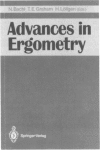Abstract
Computerized testing of 20 élite male athletes was performed to determine the effect of 7 mg kg-1 caffeine on strength and power of the knee extensors and flexors. Subjects received counterbalanced administrations of either caffeine or a placebo on two separate occasions. Peak torque (T) was measured for knee extension (ET) and flexion (FT) at angular velocities of 30 degrees, 150 degrees and 300 degrees s-1. Additionally, performance for the first 125 ms (TAE) and power (W) were recorded during 300 degrees s-1. Testing sessions were held 1 week apart, at which time the placebo/caffeine administration was reversed. A 2 x 2 repeated measures analysis of variance supplemented with a Neuman-Keuls post hoc test showed the following--significant caffeine-related increases (P < 0.05) for ET at 30 degrees s-1, ET at 300 degrees s-1, and ETAE, and EW at 300 degrees s-1. Dependent t-tests performed for pre- to post-test means showed significant changes for the caffeine group in ET at 30 degrees s-1, FT at 30 degrees s-1, FT at 150 degrees s-1, ET at 300 degrees s-1, FT at 300 degrees s-1, E and FTAE, and EW at 300 degrees s-1. No significant effects were found for the placebo trial in any variable. It was concluded that caffeine can favourably affect some strength parameters in highly resistance-trained males. However, differences in subject fibre type, motivation and caffeine sensitivity need to be elucidated.
Full text
PDF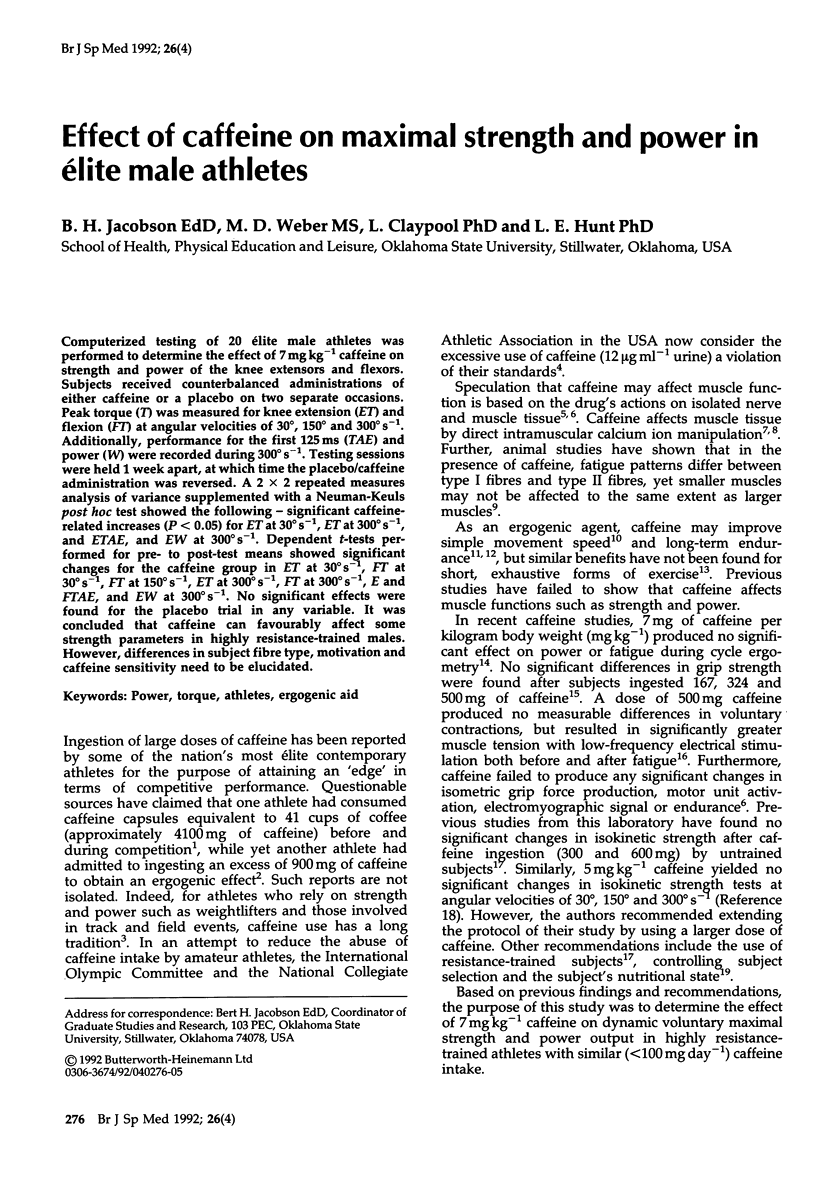
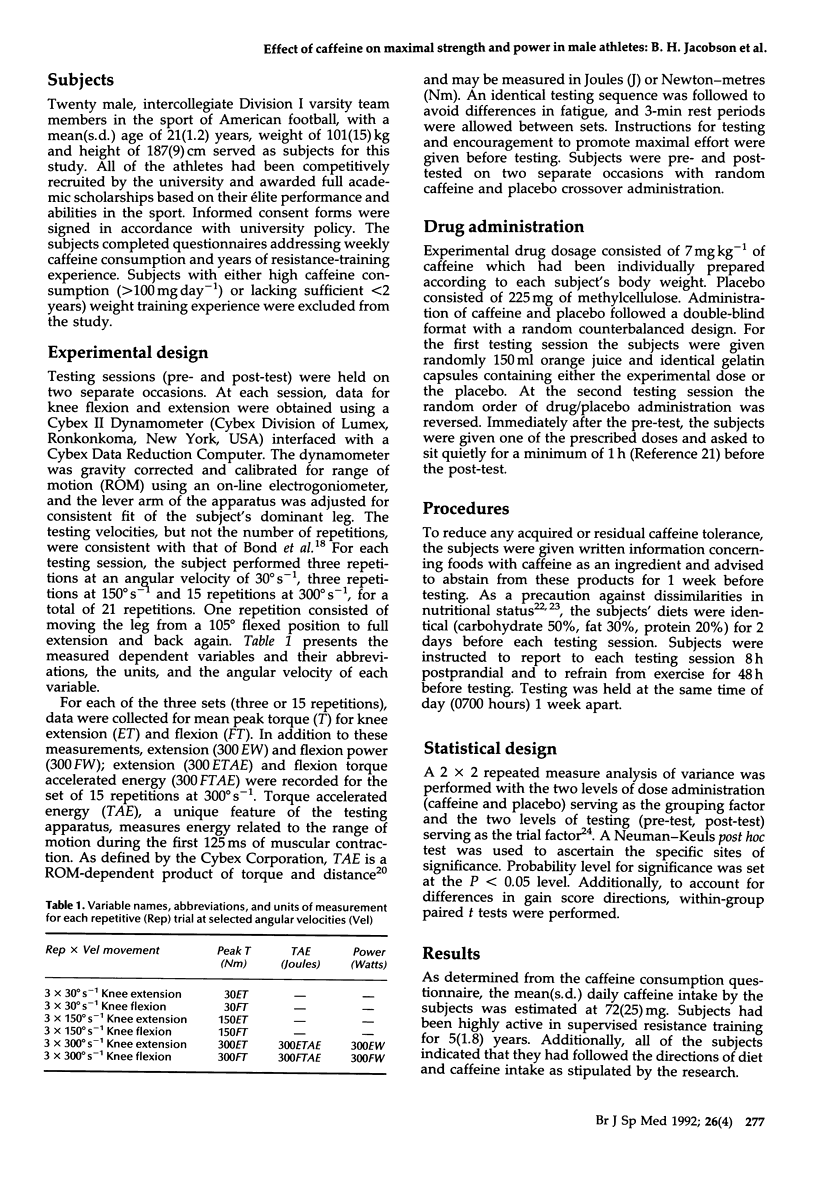
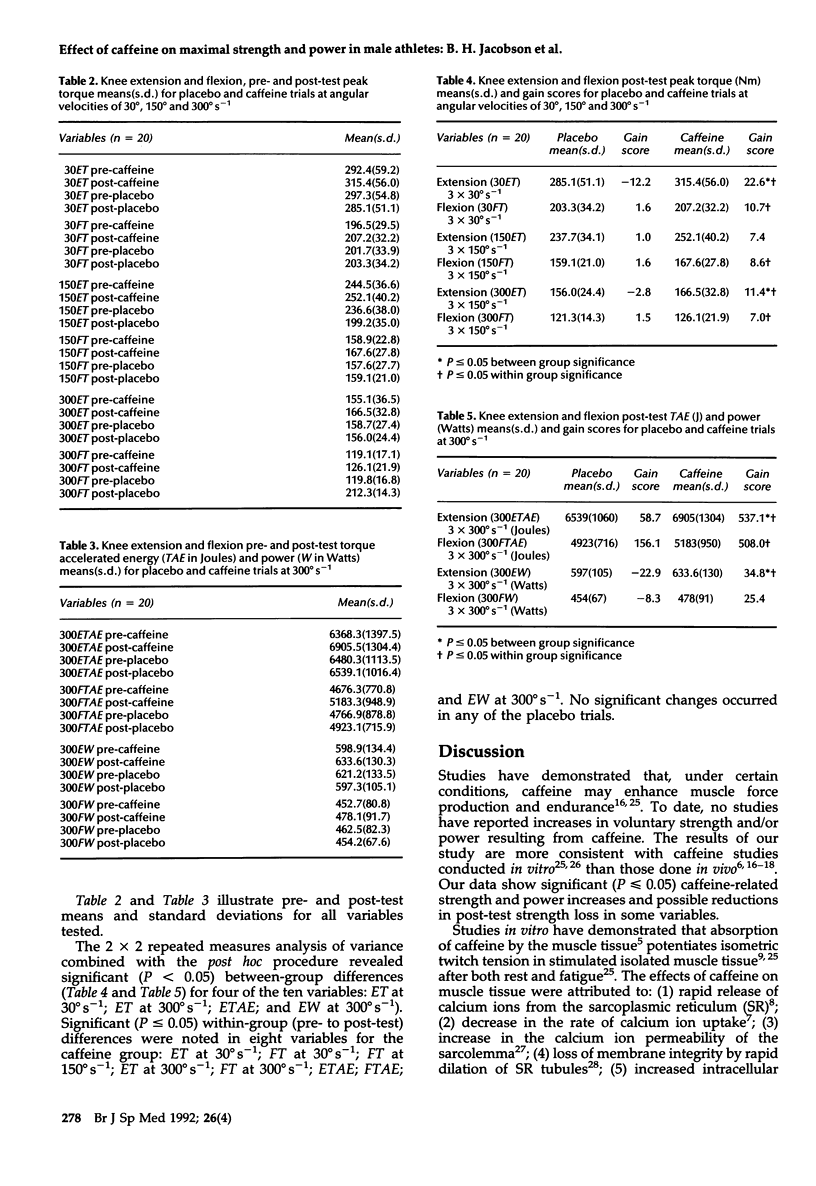
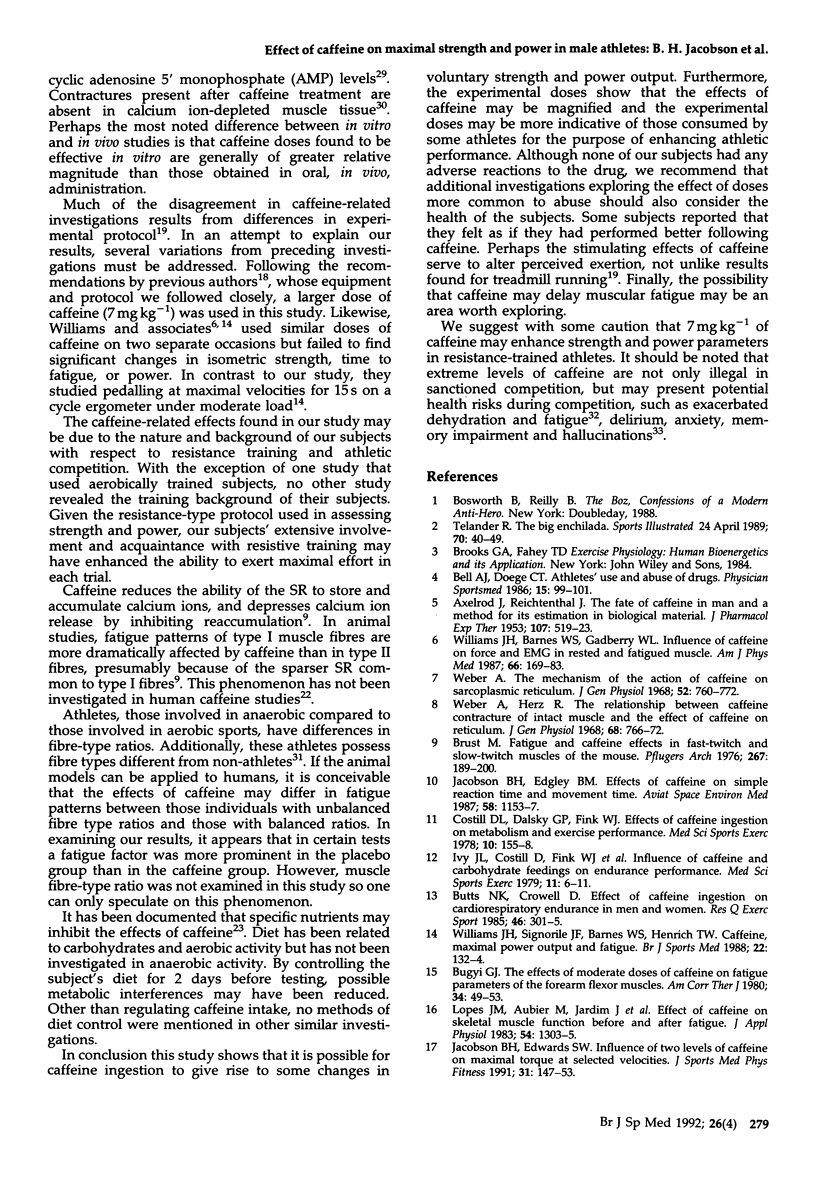
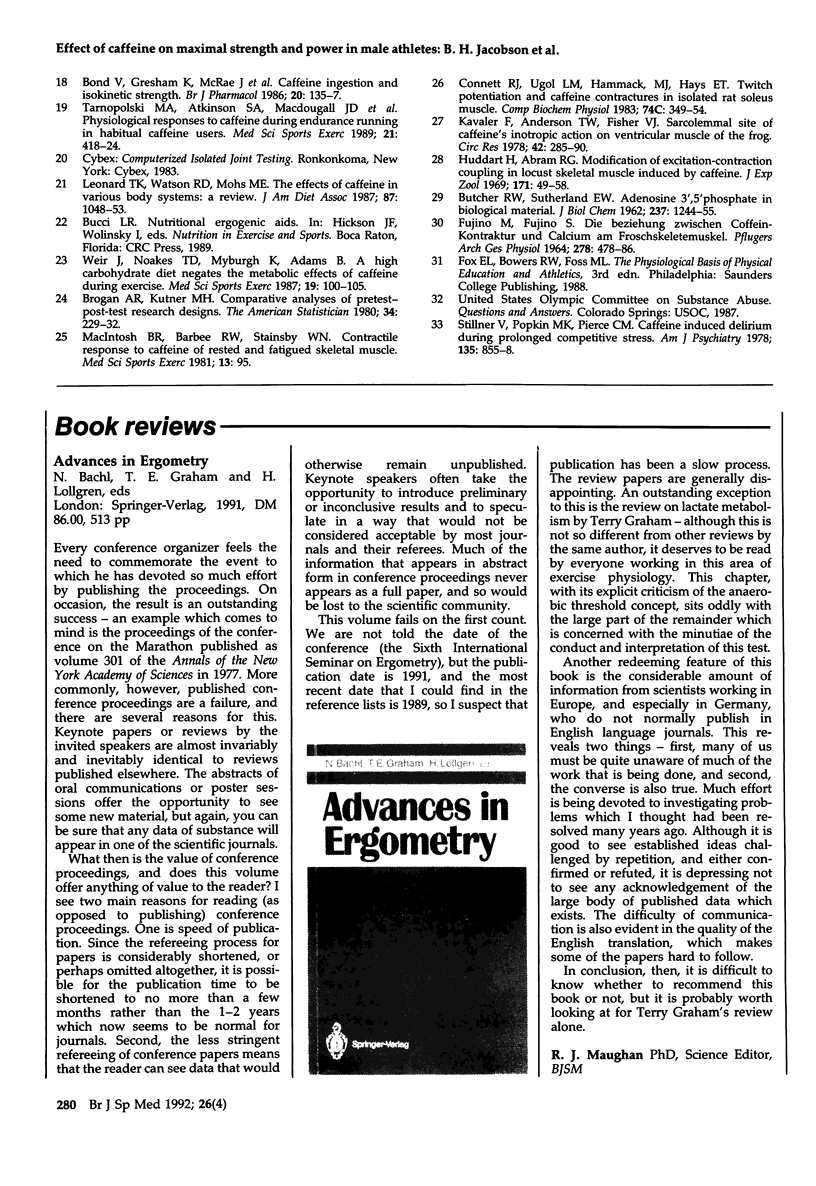
Images in this article
Selected References
These references are in PubMed. This may not be the complete list of references from this article.
- AXELROD J., REICHENTHAL J. The fate of caffeine in man and a method for its estimation in biological material. J Pharmacol Exp Ther. 1953 Apr;107(4):519–523. [PubMed] [Google Scholar]
- BUTCHER R. W., SUTHERLAND E. W. Adenosine 3',5'-phosphate in biological materials. I. Purification and properties of cyclic 3',5'-nucleotide phosphodiesterase and use of this enzyme to characterize adenosine 3',5'-phosphate in human urine. J Biol Chem. 1962 Apr;237:1244–1250. [PubMed] [Google Scholar]
- Bond V., Gresham K., McRae J., Tearney R. J. Caffeine ingestion and isokinetic strength. Br J Sports Med. 1986 Sep;20(3):135–137. doi: 10.1136/bjsm.20.3.135. [DOI] [PMC free article] [PubMed] [Google Scholar]
- Brust M. Fatigue and caffeine effects in fast-twitch and slow-twitch muscles of the mouse. Pflugers Arch. 1976 Dec 28;367(2):189–200. doi: 10.1007/BF00585157. [DOI] [PubMed] [Google Scholar]
- Bugyi G. J. The effects of moderate doses of caffeine on fatigue parameters of the forearm flexor muscles. Am Correct Ther J. 1980 Mar-Apr;34(2):49–53. [PubMed] [Google Scholar]
- Connett R. J., Ugol L. M., Hammack M. J., Hays E. T. Twitch potentiation and caffeine contractures in isolated rat soleus muscle. Comp Biochem Physiol C. 1983;74(2):349–354. doi: 10.1016/0742-8413(83)90113-5. [DOI] [PubMed] [Google Scholar]
- Costill D. L., Dalsky G. P., Fink W. J. Effects of caffeine ingestion on metabolism and exercise performance. Med Sci Sports. 1978 Fall;10(3):155–158. [PubMed] [Google Scholar]
- FUJINO M., FUJINO S. DIE BEZIEHUNG ZWISCHEN COFFEIN-KONTRAKTUR UND CALCIUM AM FROSCHSKELETMUSKEL. Pflugers Arch Gesamte Physiol Menschen Tiere. 1964;278:478–486. [PubMed] [Google Scholar]
- Huddart H., Abram R. G. Modification of excitation-contraction coupling in locust skeletal muscle induced by caffeine. J Exp Zool. 1969 May;171(1):49–58. doi: 10.1002/jez.1401710108. [DOI] [PubMed] [Google Scholar]
- Ivy J. L., Costill D. L., Fink W. J., Lower R. W. Influence of caffeine and carbohydrate feedings on endurance performance. Med Sci Sports. 1979 Spring;11(1):6–11. [PubMed] [Google Scholar]
- Jacobson B. H., Edgley B. M. Effects of caffeine on simple reaction time and movement time. Aviat Space Environ Med. 1987 Dec;58(12):1153–1156. [PubMed] [Google Scholar]
- Jacobson B. H., Edwards S. W. Influence of two levels of caffeine on maximal torque at selected angular velocities. J Sports Med Phys Fitness. 1991 Jun;31(2):147–153. [PubMed] [Google Scholar]
- Leonard T. K., Watson R. R., Mohs M. E. The effects of caffeine on various body systems: a review. J Am Diet Assoc. 1987 Aug;87(8):1048–1053. [PubMed] [Google Scholar]
- Lopes J. M., Aubier M., Jardim J., Aranda J. V., Macklem P. T. Effect of caffeine on skeletal muscle function before and after fatigue. J Appl Physiol Respir Environ Exerc Physiol. 1983 May;54(5):1303–1305. doi: 10.1152/jappl.1983.54.5.1303. [DOI] [PubMed] [Google Scholar]
- Stillner V., Popkin M. K., Pierce C. M. Caffeine-induced delirium during prolonged competitive stress. Am J Psychiatry. 1978 Jul;135(7):855–856. doi: 10.1176/ajp.135.7.855. [DOI] [PubMed] [Google Scholar]
- Tarnopolsky M. A., Atkinson S. A., MacDougall J. D., Sale D. G., Sutton J. R. Physiological responses to caffeine during endurance running in habitual caffeine users. Med Sci Sports Exerc. 1989 Aug;21(4):418–424. [PubMed] [Google Scholar]
- Weber A. The mechanism of the action of caffeine on sarcoplasmic reticulum. J Gen Physiol. 1968 Nov;52(5):760–772. doi: 10.1085/jgp.52.5.760. [DOI] [PMC free article] [PubMed] [Google Scholar]
- Weir J., Noakes T. D., Myburgh K., Adams B. A high carbohydrate diet negates the metabolic effects of caffeine during exercise. Med Sci Sports Exerc. 1987 Apr;19(2):100–105. [PubMed] [Google Scholar]
- Williams J. H., Barnes W. S., Gadberry W. L. Influence of caffeine on force and EMG in rested and fatigued muscle. Am J Phys Med. 1987 Aug;66(4):169–183. [PubMed] [Google Scholar]
- Williams J. H., Signorile J. F., Barnes W. S., Henrich T. W. Caffeine, maximal power output and fatigue. Br J Sports Med. 1988 Dec;22(4):132–134. doi: 10.1136/bjsm.22.4.132. [DOI] [PMC free article] [PubMed] [Google Scholar]



